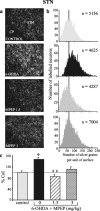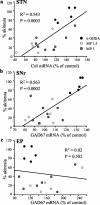Metabotropic glutamate 5 receptor blockade alleviates akinesia by normalizing activity of selective basal-ganglia structures in parkinsonian rats
- PMID: 12967992
- PMCID: PMC6740696
- DOI: 10.1523/JNEUROSCI.23-23-08302.2003
Metabotropic glutamate 5 receptor blockade alleviates akinesia by normalizing activity of selective basal-ganglia structures in parkinsonian rats
Abstract
Glutamate overactivity within the basal ganglia has been shown to be central to the expression of motor symptoms in advanced stages of Parkinson's disease, and metabotropic glutamate receptors (mGluRs) represent promising targets for new therapeutic strategies in this pathology. Little is known, however, about the cellular and behavioral changes occurring in the early stages of the disease when dopamine depletion is moderate. Here, we report that rats with partial bilateral dopamine lesions exhibit akinetic deficits associated with dramatically increased neuronal metabolic activity in selective structures of the basal ganglia such as the subthalamic nucleus and the substantia nigra pars reticulata, but not in the entopeduncular nucleus. Furthermore, chronic treatment with the mGluR5 antagonist 2-methyl-6-(phenylethylnyl)-pyridine alleviated the akinesia and was associated with a normalization of the activity of these two overactive structures. These data stress the therapeutic potential of mGluR5 antagonists in the treatment of parkinsonian patients in the early stages of the disease.
Figures





Similar articles
-
Prolonged blockade of NMDA or mGluR5 glutamate receptors reduces nigrostriatal degeneration while inducing selective metabolic changes in the basal ganglia circuitry in a rodent model of Parkinson's disease.Neurobiol Dis. 2006 Apr;22(1):1-9. doi: 10.1016/j.nbd.2005.09.010. Epub 2005 Nov 11. Neurobiol Dis. 2006. PMID: 16289868
-
Effect of subthalamic nucleus or entopeduncular nucleus lesion on levodopa-induced neurochemical changes within the basal ganglia and on levodopa-induced motor alterations in 6-hydroxydopamine-lesioned rats.J Neurochem. 2003 Sep;86(6):1328-37. doi: 10.1046/j.1471-4159.2003.01960.x. J Neurochem. 2003. PMID: 12950442
-
Effects of early and delayed treatment with an mGluR5 antagonist on motor impairment, nigrostriatal damage and neuroinflammation in a rodent model of Parkinson's disease.Brain Res Bull. 2010 Apr 29;82(1-2):29-38. doi: 10.1016/j.brainresbull.2010.01.011. Epub 2010 Jan 25. Brain Res Bull. 2010. PMID: 20100549
-
Dysfunction of the cortico-basal ganglia-cortical loop in a rat model of early parkinsonism is reversed by metabotropic glutamate receptor 5 antagonism.Eur J Neurosci. 2005 Dec;22(11):2765-74. doi: 10.1111/j.1460-9568.2005.04498.x. Eur J Neurosci. 2005. PMID: 16324110
-
Neuroinformatics and modeling of the basal ganglia: bridging pharmacology and physiology.Expert Rev Med Devices. 2007 Sep;4(5):663-72. doi: 10.1586/17434440.4.5.663. Expert Rev Med Devices. 2007. PMID: 17850200 Review.
Cited by
-
Differential Role of mGluR5 in Cognitive Processes in Posttraumatic Stress Disorder and Major Depression.Chronic Stress (Thousand Oaks). 2022 Aug 4;6:24705470221105804. doi: 10.1177/24705470221105804. eCollection 2022 Jan-Dec. Chronic Stress (Thousand Oaks). 2022. PMID: 35958037 Free PMC article.
-
Closed-Loop Implantable Therapeutic Neuromodulation Systems Based on Neurochemical Monitoring.Front Neurosci. 2019 Aug 20;13:808. doi: 10.3389/fnins.2019.00808. eCollection 2019. Front Neurosci. 2019. PMID: 31481864 Free PMC article. Review.
-
Metabotropic glutamate receptors: from the workbench to the bedside.Neuropharmacology. 2011 Jun;60(7-8):1017-41. doi: 10.1016/j.neuropharm.2010.10.022. Epub 2010 Oct 29. Neuropharmacology. 2011. PMID: 21036182 Free PMC article. Review.
-
Metabotropic glutamate receptors: targets for neuroprotective therapies in Parkinson disease.Curr Opin Pharmacol. 2018 Feb;38:72-80. doi: 10.1016/j.coph.2018.03.004. Epub 2018 Mar 30. Curr Opin Pharmacol. 2018. PMID: 29605730 Free PMC article. Review.
-
Benzimidazoles as Potent and Orally Active mGlu5 Receptor Antagonists with an Improved PK Profile.ACS Med Chem Lett. 2010 Nov 2;2(1):58-62. doi: 10.1021/ml100215b. eCollection 2011 Jan 13. ACS Med Chem Lett. 2010. PMID: 24900255 Free PMC article.
References
-
- Amalric M, Berhow M, Polis I, Koob GF ( 1993) Selective effects of low-dose D2 dopamine receptor antagonism in a reaction-time task in rats. Neuropsychopharmacology 8 : 195-200. - PubMed
-
- Amalric M, Baunez C, Nieoullon A ( 1995a) Does the blockade of excitatory amino acid transmission in the basal ganglia simply reverse reaction time deficits induced by dopamine inactivation? Behav Pharmacol 6 : 508-519. - PubMed
-
- Amalric M, Moukhles H, Nieoullon A, Daszuta A ( 1995b) Complex deficits on reaction time performance following bilateral intrastriatal 6-OHDA infusion in the rat. Eur J Neurosci 7 : 972-980. - PubMed
-
- Anderson JJ, Rao SP, Rowe B, Giracello DR, Holtz G, Chapman DF, Tehrani L, Bradbury MJ, Cosford NDP, Varney MA ( 2002) [3H] Methoxymethyl-3-[(2-methyl-1,3-thiazol-4-yl)ethynyl]pyridine binding to metabotropic glutamate receptor subtype 5 in rodent brain: in vitro and in vivo characterization. J Pharmacol Exp Ther 303 : 1044-1051. - PubMed
Publication types
MeSH terms
Substances
LinkOut - more resources
Full Text Sources
Other Literature Sources
Miscellaneous
